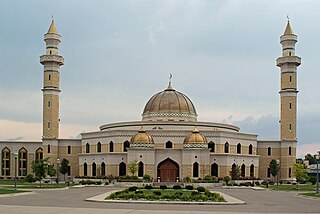
Xenophobia is the fear or dislike of anything which is perceived as being foreign or strange. It is an expression which is based on the perception that a conflict exists between an in-group and an out-group and it may manifest itself in suspicion of one group's activities by members of the other group, a desire to eliminate the presence of the group which is the target of suspicion, and fear of losing a national, ethnic, or racial identity.
Islamophobia is the irrational fear of, hatred of, or prejudice against the religion of Islam or Muslims in general, especially when perceived by outsiders as a geopolitical force or a source of terrorism.

Islam is the third largest religion in the United States (1%), behind Christianity (63%) and Judaism (2%), and equaling the shares of Buddhism and Hinduism. A 2017 study estimated that 1.1% of the population of the United States are Muslim. In 2017, twenty states, mostly in the South and Midwest, reported Islam to be the largest non-Christian religion. In 2020, the U.S. Religion Census found there to be 4.45 million Muslim Americans, or roughly 1.3% of the population.

"Eurabia" is a far-right, anti-Muslim conspiracy theory that posits that globalist entities, led by French and Arab powers, aim to Islamize and Arabize Europe, thereby weakening its existing culture and undermining its previous alliances with the United States and Israel.

Islam is the second largest religion in the Netherlands, after Christianity, and is practised by 5% of the population according to 2018 estimates. The majority of Muslims in the Netherlands belong to the Sunni denomination. Many reside in the country's four major cities: Amsterdam, Rotterdam, The Hague and Utrecht.

Islam is a minority religion in Italy. Muslim presence in Italy dates back to the 9th century, when Sicily came under control of the Aghlabid Dynasty. There was a large Muslim presence in Italy from 827 until the 12th century. The Norman conquest of Sicily led to a gradual decline of Islam, due to the conversions and emigration of Muslims toward Northern Africa. A small Muslim community however survived at least until 1300.

Islam is the second largest religion in Australia. According to the 2021 Census in Australia, the combined number of people who self-identified as Muslims in Australia, from all forms of Islam, constituted 813,392 people, or 3.2% of the total Australian population. That total Muslim population makes Islam, in all its denominations and sects, the second largest religious grouping in Australia, after all denominations of Christianity.

Islam is the second-largest religion in Europe after Christianity. Although the majority of Muslim communities in Western Europe formed recently, there are centuries-old Muslim communities in the Balkans, Caucasus, Crimea, and Volga region. The term "Muslim Europe" is used to refer to the Muslim-majority countries in the Balkans and the Caucasus and parts of countries in Eastern Europe with sizable Muslim minorities that constitute large populations of indigenous European Muslims, although the majority are secular.
Opposition to immigration, also known as anti-immigration, is a political ideology that seeks to restrict the incoming of people from one area to another. In the modern sense, immigration refers to the entry of people from one state or territory into another state or territory in which they are not citizens in contrast, but closely correspond to emigration which refers people leaving one state or territory in which they are citizens. Illegal immigration occurs when people immigrate to a country without having official permission to do so. Opposition to immigration ranges from calls for various immigration reforms, to proposals to completely restrict immigration, to calls for repatriation of existing immigrants.
Document.no is a Norwegian far-right anti-immigration online newspaper. Academics have identified Document.no as an anti-Muslim website permeated by the Eurabia conspiracy theory. The website received global media attention in connection with the 2011 Norway attacks due to its association with perpetrator Anders Behring Breivik, a former comment section poster on the website.
Anti–Middle Eastern sentiment is hostility to, prejudice towards, or discrimination against people who belong to or originate from the various ethnic groups of the Middle East. Although it is commonly associated with Islamophobia, as Muslims constitute the majority of the region's population, it is a distinct type of hatred in itself and may not always stem from religion-based animosity. People who harbour negative feelings towards the region's people view them as barbaric and inferior on racial, ethnic, cultural, or religious grounds, or a combination of any of these factors.

American Muslims often face Islamophobia and racialization due to stereotypes and generalizations ascribed to them. Due to this, Islamophobia is both a product of and a contributor to the United States' racial ideology, which is founded on socially constructed categories of profiled features, or how people seem.
Islamophobia in Australia is highly speculative and affective distrust and hostility towards Muslims, Islam, and those perceived as following the religion. This social aversion and bias is often facilitated and perpetuated in the media through the stereotyping of Muslims as violent and uncivilised. Various Australian politicians and political commentators have capitalised on these negative stereotypes and this has contributed to the marginalisation, discrimination and exclusion of the Muslim community.
Islamophobia in the media refers to negative coverage of Islam-related topics, Muslims, or Arabs by media outlets in a way that is hostile, untrue, and/or misleading. Islamophobia is defined as "Intense dislike or fear of Islam, especially as a political force; hostility or prejudice towards Muslims", and the study of how and to what extent the media furthers Islamophobia has been the subject of much academic and political discussion.
Islamophobia in Canada refers to a set of discourses, behaviours and structures which express feelings of anxiety, fear, hostility and rejection towards Islam or Muslims in Canada.

Cultural racism, sometimes called neo-racism, new racism, postmodern racism, or differentialist racism, is a concept that has been applied to prejudices and discrimination based on cultural differences between ethnic or racial groups. This includes the idea that some cultures are superior to others or in more extreme cases that various cultures are fundamentally incompatible and should not co-exist in the same society or state. In this it differs from biological or scientific racism, which refers to prejudices and discrimination rooted in perceived biological differences between ethnic or racial groups.

Islamophobia in China refers to the set of discourses, behaviors and structures which express feelings of anxiety, fear, hostility and rejection towards Islam and/or Muslims in China.
Islamophobia in Sweden refers to the set of discourses, behaviours and structures which express feelings of anxiety, fear, hostility and rejection towards Islam and/or Muslims in Sweden. Historically, attitudes towards Muslims in Sweden have been mixed with relations being largely negative in the early 16th century, improving in the 18th century, and declining once again with the rise of Swedish nationalism in the early 20th century. According to Jonas Otterbeck, a Swedish historian of religion, attitudes towards Islam and Muslims today have improved but "the level of prejudice was and is still high." Islamophobia can manifest itself through discrimination in the workforce, prejudiced coverage in the media, and violence against Muslims. The anti-immigration and anti-Islam Sweden Democrats is the second largest party in the Riksdag.
Islamophobia in France holds a particularly political significance since France has the largest proportion of Muslims in the Western world, primarily due to the migration from Maghrebi, West African, and Middle Eastern countries. The existence of discrimination against Muslims is reported by the media in the Muslim world and by the perceived segregation and alienation of Muslims within the French community. The belief that there is an anti-Muslim climate in France is heavily criticised by some members of the French Muslim community who terms it an 'exaggeration'.
Islamophobia in Poland is the fear, hatred of, or prejudice against the Islamic religion or Muslims in Poland. Since the Muslim community in Poland is small the situation has been described as "Islamophobia without Muslims". According to Monika Bobako, Islamophobia is one of the main elements of the Polish nationalist discourse. Islamophobia in Poland takes the form of racism and xenophobia towards Muslims or those perceived as Muslim.









